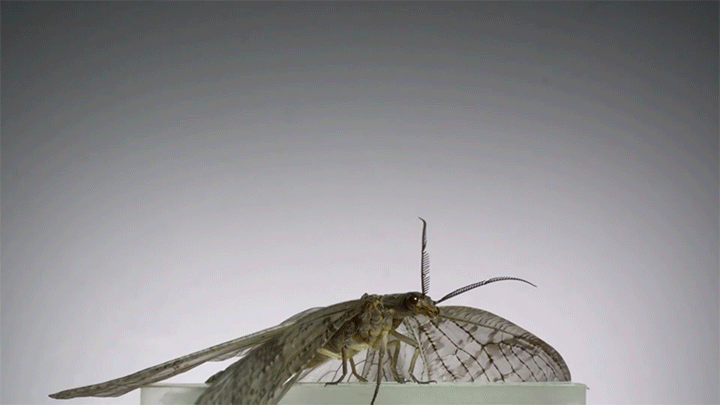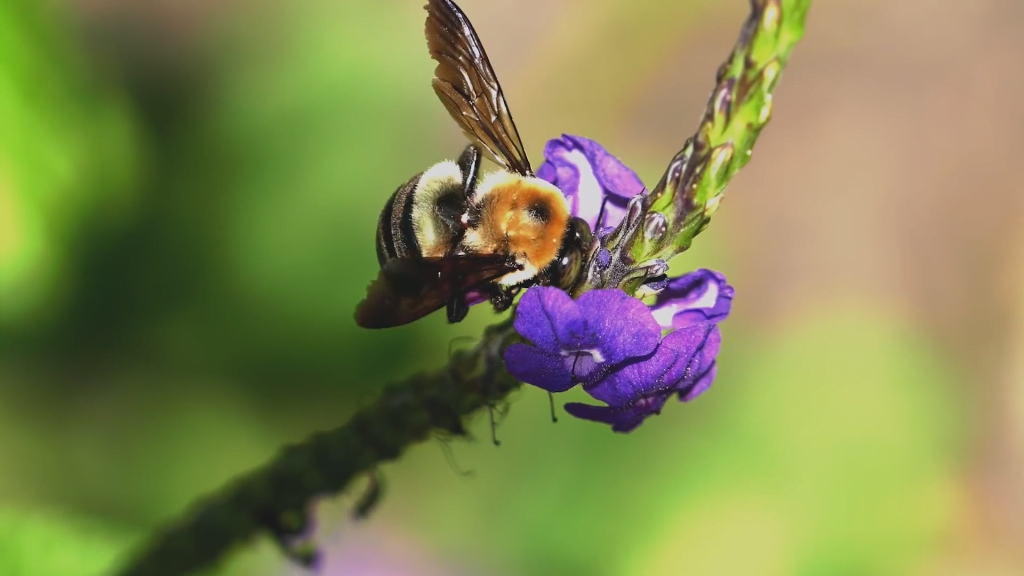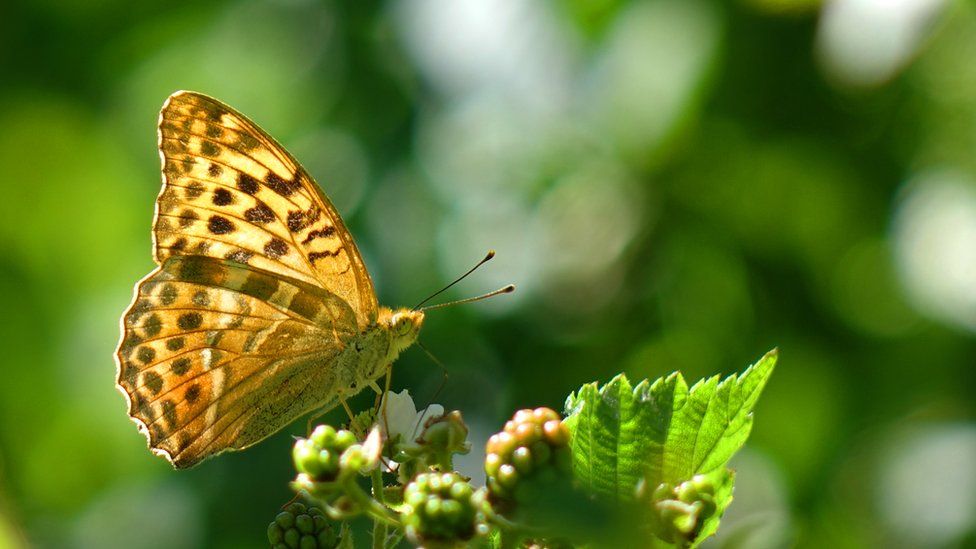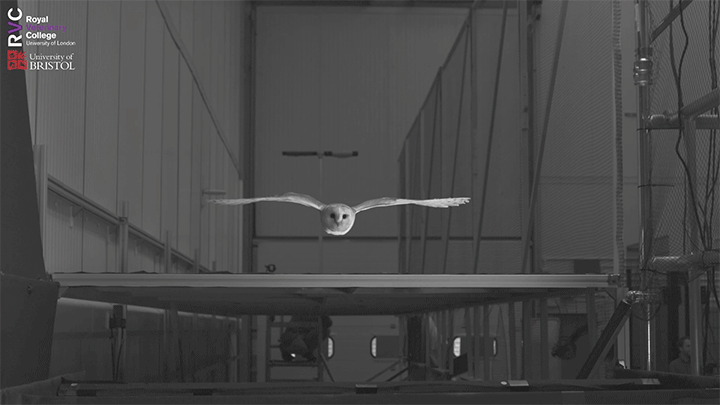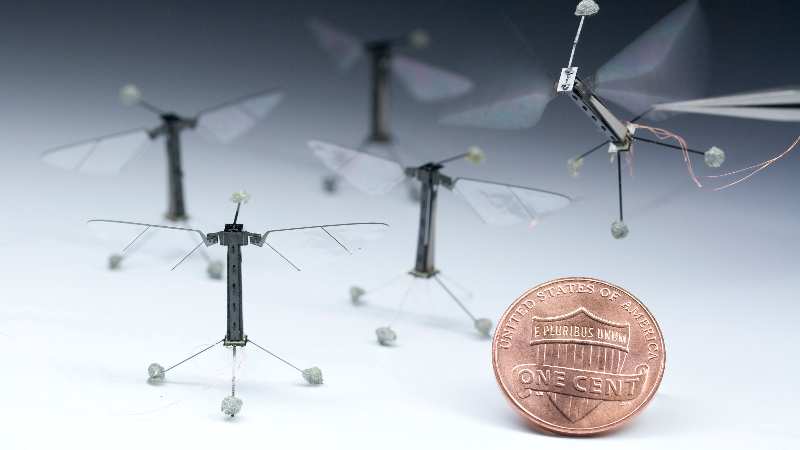What do you do when you’re an insect researcher with a high-speed camera? Why, film all sorts of unusual insects from your backyard as they take off and fly! Here Dr. Adrian Smith of Ant Lab shows us a slew of insects that are not unusual for their rarity — you can probably find many of these in your own yard — but they are rarely seen in insect flight research. Like many of the species we’ve seen before, lots of these fliers use a figure-8 wingstroke to stay aloft. But one feature that really struck me as I watched was how amazingly flexible many of their wings were. For many of them, parts of their wings actually curl back on themselves during parts of the stroke. As engineers, our first instinct would be to avoid that kind of complexity, but I expect that it must give the insects some kind of benefit — otherwise nature would have eliminated it. (Image and video credit: Ant Lab/A. Smith; via Colossal)
Tag: flapping flight

How the Hummingbird Got Its Hum
Summer hikes in the Rocky Mountains are frequently pierced by a hum that can deepen to a bomber-like buzz as hummingbirds flit by. They’re so small and fast that they’re hard to see, but they’re never hard to hear. A new study pins down just where that telltale hum comes from.
To determine the specific origin of the hummingbird’s sound, researchers observed hovering hummingbirds with an array of over 2,000 microphones and multiple high-speed cameras. With this set-up, they could create a 3D acoustic map of the bird’s sounds, correlated with its motions. They found that the bird’s sounds come primarily from aerodynamic forces generated during their distinctive wingstroke – not from vortices or the fluttering of their feathers.
They also found that the hummingbird’s fast wingstroke — about 40 times per second — fed into sounds at 40 and 80 Hz, as well as higher frequency overtones. Since these sounds are well within human hearing range, they make up most of what we hear from the birds. (Image credit: P. Bonnar; research credit: B. Hightower; via The Guardian; submitted by Kam-Yung Soh)

Insect-Inspired Flight
Insects are incredibly agile and resilient fliers, capable of colliding and recovering without damage. Engineers are only beginning to capture these characteristics in their robots. Here, engineers use a soft actuator — a rubber cylinder coated in carbon nanotubes — to drive their robot’s flight. When voltage is applied across the carbon nanotubes, the rubber squeezes and stretches, causing the robot’s wings to flap. These soft actuators are far less fragile than hard ones, allowing the robots to take hits and keep flapping, much like the real insects. (Image and video credit: MIT News; research credit: K. Chen et al.)

Flexible Wings Aid Butterfly Flight
Butterflies are some of the oddest flyers of the insect world, given the large size of their wings relative to their bodies. That could be a recipe for inefficient flight, but a new study shows that butterflies’ large flexible wings actually help them take off quickly.
When lifting their wings, butterflies use an unusual clapping motion, with the leading edges of their wings coming together before the rest of the wings. This motion helps cup and direct air, creating most of the butterfly’s thrust, according to the researchers. The wings’ flexibility is key to this. Using artificial wings — both stiff and flexible — researchers found that the flexible wings generated 22% more useful impulse and were 28% more efficient. For a tiny flyer with frequent take-offs, that’s an enormous savings! (Image, video, and research credit: L. Johansson and P. Henningsson; via BBC; submitted by Kam-Yung Soh)

Adjusting for Gusts
In flight, birds must adjust quickly to wind gusts or risk crashing. Research shows that the structure of birds’ wings enables them to respond faster than their brains can. The wings essentially act like a suspension system, with the shoulder joint allowing them to lift rapidly in response to vertical gusts. This motion keeps the bird’s head and torso steady, so they can focus on more complex tasks like landing, obstacle avoidance, and prey capture. (Image and research credit: J. Cheney et al.; submitted by Kam-Yung Soh)

Hummingbird Flight in Slow Motion
Hummingbirds are impressive, acrobatic flyers. Their figure-8 wing stroke pattern produces about 70% of their lift on the downstroke, and the remainder during the backward upstroke. But their tails and body motions also play an important role in stabilizing them, especially in gusty winds. They also have some impressive feeding dynamics. Altogether, they’re one of the most precise flyers in the animal kingdom! (Video and image credit: BBC Earth)

Mimicking Insect Flight
There’s an oft-repeated tale that science cannot explain how a bumblebee flies. And while that may have been true 80 years ago, when engineers assumed they could apply their knowledge of fixed-wing aircraft to insects, it’s very far from the truth now.
Being small, insects use aerodynamic tricks that are very different from the physics used by aircraft or even birds. Insects like fruit flies use a forward-and-backward sweeping motion at a very high angle of attack as they flap. This motion creates a vortex at the leading edge of the wing that provides the lift keeping the insect aloft. It still requires fast reflexes — most insects flap their wings hundreds of times a second — but the mechanism is robust enough to keep insects aloft and maneuverable. (Image credits: Robobee – K. Ma and P. Chirarattananon, simulation – F. T. Muijres et al., illustration – G. Lauder; via APS Physics)

How Did Pterosaurs Fly?
One of my favorite aspects of fluid dynamics is how well it pairs with so many other fields, from mathematics and space exploration to biology, medicine, and even paleontology. That last field is key to today’s question, namely: how did a prehistoric reptile the size of an F-16 manage to fly?
As Joe’s video describes, many factors went into Quetzalcoatlus’ flight. The pterosaur had strong but hollow bones to save on weight while anchoring flight muscles. Its wing shape mimicked an airfoil’s. And, finally, it overcame the challenge of taking off by using both its front and hind limbs to leap off the ground, much like modern bats do.
There’s no doubt that it would be stunning (and probably terrifying!) to see these creatures in action. But you may wonder how scientists piece together these animals from incomplete fossils. Don’t worry! There’s a video for that question, too. (Video and image credit: It’s Okay to Be Smart; see also the video’s references)

“Ornitographies”
If birds left trails in the sky, what would they look like? This is the question that haunted photographer Xavi Bou and inspired him to create his “Ornitographies” series. Using video of birds in flight, he combines frames to construct these snapshots of flight. In them, birds become streaklines feathered with wingbeats.
I love how the technique highlights the patterns of flapping flight. A bird flying steadily over a lake becomes a wavy line with consistent, perfectly matched up- and downstrokes, whereas a bird just taking off has short, fast wingbeats that slowly lengthen and steady out as the bird gets aloft. Flocks of birds turn into a tornado of swirling lines as they land or take-off en mass. (Image credit: X. Bou; via Flow Vis)



